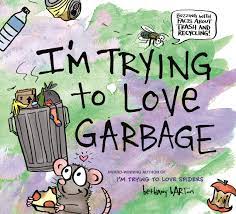"Planet Earth is a big, busy place.
One study says there are over
eight million different species of
living things on planet earth.
WHOA.
Thankfully, nature has a pretty
sweet system going on, with food
chains making sure living organisms
use each other for food and energy."
Do you know the difference between scavengers, decomposers and detritivores? Pardon? Can you say that again, please? I am quite sure I had not heard the term detritivore before I read this book. I know the word 'detritus'. I should have been able to figure it out, I guess.
Thanks to Bethany Barton, I only had to keep reading. She explains it all in this marvelous book about garbage. The garbage collectors are quick to introduce themselves to the neighborhood narrator, and to do a great job of explaining how they get rid of nature's garbage. A captioned page about the food chain is helpful. There is a caution that there is more to it than that.
"Because every living thing creates waste ... "
Garbage in nature has to go somewhere. You will know about scavengers (vultures, rats, cockroaches, termites) and maybe even decomposers ('organisms that break down the waste of and remains of living things'). Turns out that a detritivore eats trash. They do their work on land, and in the oceans. They do not help with inorganic waste. They are NOT designed for that.
The author goes on to describe what happens to human trash, and the landfills that can be overwhelmed, in both size and stench. There is a solution. She uses the last few pages to explain what readers can do to make a difference where they live. All that is needed is to think about what we do with our garbage. What did you do with all the garbage that collects at Christmas time?
Chatty dialogue, cartoon-like illustrations and a clear message assure this to be a worthwhile addition to classroom, public and home libraries. It is a worthy introduction to an important topic, and will surely lead interested children to find out more.













No comments:
Post a Comment